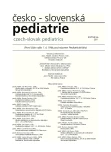Disorders in food intake from the child psychiatrist point of view
Authors:
M. Paulinyová; J. Šuba; Z. Hradečná
Authors‘ workplace:
Klinika detskej psychiatrie LFUK, Detská fakultná nemocnica, Bratislava
prednosta doc. MUDr. I. Škodáček, CSc.
Published in:
Čes-slov Pediat 2011; 66 (3): 169-176.
Category:
Original Papers
Overview
Eating disorders are presently seen as a serious problem because of their increasing incidence on the worldwide basis. Eating disorders in general as well as eating disorders in children and adolescents are multifactorial in their origin with significant genetic, biological, psychological, familial, and sociocultural risk factors.
Recent research has revealed new facts about biological causes of eating disorders. One of the new key discoveries is the relationship between some of the neurotransmitters (e.g. serotonin) and anxiety or avoidant temperamental characteristics of patients with mental anorexia. Because of the high risk of the disorder, early diagnosis is required. Patients with eating disorders frequently present also with other comorbid conditions, namely anxieties and depressions. The course of the disorder is very often chronic and leads to complications and therapy resistance. The most serious and risk consequences of mental anorexia are cardio-vascular problems, problems with internal environment and endocrinological complications. Therefore the somatic examination should be comprehensive and urgent.
Treatment of patients with eating disorders should reflect its multifactorial ethiology and include a comprehensive therapeutic approach. The aim of the therapy should be not only the acheivement of a healthy weight, but equally also a change in the thinking styles and attitudes towards eating and body image. The key principle of a successful treatment is the cooperation of the psychiatrist and the paediatrician starting with the identification of somatic consequences of the disorder and monitoring of the patient’s state followed by the appropriate therapy.
Key words:
anorexia nervosa, bulimia nervosa, assessment, neurobiological causes, treatment
Sources
1. Papežová H. Poruchy příjmu potravy. In: Libiger J, Švestka J, Höschl C. Psychiatrie. 2. vyd. Praha: Tigis, s. r. o., 2004: 609–620.
2. Treasure JL. Getting beneath the phenotype of anorexia nervosa: the search for viable endophenotypes and genotypes. Can J Psychiatry 2007; 52(4): 212–219.
3. Halmi K. Anorexia nervosa and bulimia nervosa. In: Martin A, Volkmar FR. Lewis´s Child and Adolescent Psychiatry. 4th ed. Wolters Kluwer Lippincot, Williams & Wilkins, 2007: 592–602.
4. Kaye WH, Fudge JL, Paulus M. New insight into symptoms and neurocircuit function of anorexia nervosa. Nature Rev Neurosci 2009; 10(8): 573–584.
5. Krusse J, Woller W. Poruchy příjmu potravy. In: Tress W. Základní psychosomatická péče. 1. vyd. Praha: Portál, 2008: 133–144.
6. Nicholls B, Lask D. Poruchy příjmu potravy v dětství a rané adolescenci. In: Krch FD, et al. Poruchy příjmu potravy. 2. vyd. Praha: Grada Publishing, 2005: 125–135.
7. Kúseková M. Poruchy jedenia (Anorexia nervosa a Bulimia nervosa). In: Šašinka M, Šagát M. Pediatria. 1. zväzok, 1. vyd. Košice: Status, 1998: 331–333.
8. O´Brien KM, Vincent NK. Psychaitric comorbidity in anorexia and bulimia nervosa, nature, prevalence, and causal relationship. Clin Psychol Rev 2003; 23(1): 57–74.
9. Dimová N, Kolibáš E, Novotný V, Obuch I, Balcarova K. Úzkostné prejavy u pacientov s poruchami príjmu potravy a ich zmeny počas liečby citalopramom. Čes slov Psychiat 1999; 95(7): 462–471.
10. Dimová N, Kolibáš E, Novotný V, Havlíčková E, Pastrnková R. Poruchy príjmu potravy a užívanie psychoaktívnych látok. Alkoholizmus a drogové závislosti (Protialkoholický obzor) 2000; 35(4–5): 207–214.
11. Halmi KA. Eating disorder. In: Kaplan HI, Sadock BJ. Kaplan & Sadock Comprehensive Textbook of Psychiatry, 7th edition on CD-ROM. Lippincott, Williams & Wilkins, 2000.
12. Zipfel S, Lowe B, Herzog W. Medical complications. In: Treasure JL,Schmidt U, Furth E. Handbook of Eating Disorders. 2nd ed. John Wiley & Sons Ltd., 2003: 169–186.
13. Tonhajzerová I, Javorka K. Zmeny autonómneho nervového systému pri poruchách príjmu potravy – mentálna anorexia. Čes-slov Pediat 2008; 63(5): 266–271.
14. Tichá Ľ, Tomečková E, Hornová J, Niňajová S, Birčák J. Funkcia endokrinných žliaz u pacientok s mentálnou anorexiou. Čes-slov Pediat 2006; 61(10): 573–577.
15. Tichá Ľ, Hornová J, Birčák J. Mentálna anorexia a jej dôsledky v pediatrickej praxi. Pediatria pre Prax (Solen) 2009; 10(2): 81–83.
16. Papežová H. Poruchy příjmu potravy. In: Seifertová D, Praško J, Horáček J, Höschl C. Postupy v léčbě psychických poruch. 2. vyd. Praha: Medical Tribune CZ, 2008: 464–479.
17. Tanner J, Whitehouse RH. Standards from birth to maturity for height, weight, height velocity and weight velocity. British children. Arch Dis Childh 1965; Part 1+Part 2(41): 454–471, 613–635.
18. Dimová N, Kolibáš E, Novotný V. Poruchy príjmu potravy – komplexný medicínsky prístup. Interná medicína, Príloha – všeobecné lekárstvo 2002; 2(1): 57–65.
19. Gowers S, Pilling S,Treasure J, et al. Eating disorder core interventions in the treatment and management of anorexia nervosa, bulimia nervosa and related eaitng disorder. Clinical Guideline 9. www.nice.org.uk/CG009NICEguideline, 2004.
20. Steinhausen HCH. The outcome of anorexia nervosa in 20th century. Am J Psychiat 2002; 159: 1284–1293.
Labels
Neonatology Paediatrics General practitioner for children and adolescentsArticle was published in
Czech-Slovak Pediatrics

2011 Issue 3
- What Effect Can Be Expected from Limosilactobacillus reuteri in Mucositis and Peri-Implantitis?
- The Importance of Limosilactobacillus reuteri in Administration to Diabetics with Gingivitis
Most read in this issue
- Pulse oximetry as a screening method for early detection of critical congenital heart disease in newborns in the region of Northern Slovakia
- Disorders in food intake from the child psychiatrist point of view
- Pulse oximetry and critical congenital heart defects in newborns – the discussion continues
- Gastroesophageral reflux in pre-term infants: 24hour multichannel intraluminal impedance/pH metry
